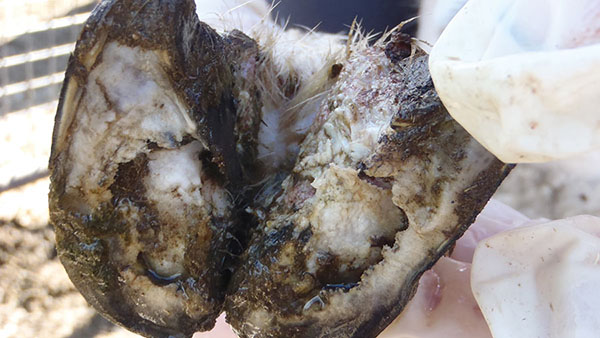Ovine foot rot is an infectious, contagious disease of sheep that causes severe lameness and economic loss from decreased flock production.
With current understanding of the disease, and aided by drugs and vaccines, control and elimination of the disease should be the goal of all sheep producers.
Ovine foot rot is a normal inhabitant of the ruminant digestive tract and in wet weather may interact with bacteria, to produce foot scald, an infection of the skin between the toes. This infection sets up the foot for invasion by more bacteria, which produces the condition referred to as foot rot.
Since Bacteroides can only live in the hoof of an infected animal or in the soil for no more than 10-14 days, it is possible, through careful management procedures, to keep from introducing foot rot into a flock and to successfully control and/or eliminate the disease if the flock is infected.
Diagnosis
Lameness is usually the major sign of an infected animal, although sheep with an early infection may not exhibit lameness. The area between the toes first becomes moist and reddened. Then the infection invades the sole of the hoof, undermining and causing separation of the horny tissues.
The infection causes a characteristic foul odour and may infect one or more feet at the same time. Not all lame sheep have foot rot. Before undertaking an eradication, treatment, or control programme, it is best to consult a veterinarian for a positive diagnosis and advice.
Other diseases that may be confused with foot rot are foot abscesses, foot scald, laminitis or founder, corns, traumatic injuries, and foreign bodies lodged between the toes.
Transmission
The bacteria that causes foot rot, Bacteroides nodosus, is spread from infected sheep to the ground, manure, bedding, etc., where it is then picked up by non-infected sheep. Foot rot is introduced by purchase of an infected animal or by simply using facilities or trucks that have been contaminated by infected sheep.
Spread occurs best when the environment is wet. Since the organism doesn’t survive long in the environment (<2 wks), carriers in the flock will continue to reinfect the flock unless the animal is either culled or the organism is eliminated by proper treatment.
Prevention
It is always easier and less expensive to prevent foot rot than to treat it after it has become established. To remain disease free, there are five management principles that will help keep foot rot from being introduced into a clean flock.
*Never buy sheep with foot rot or from a flock infected with foot rot, even if the animal(s) appear unaffected.
Avoid buying sheep at sale yards or livestock markets where clean and infected sheep may have been commingled or run through the same area.
*Avoid using facilities (trails, corrals, dipping areas) where infected sheep may have been in the last two weeks.
*Never transport sheep in a vehicle that has not been properly cleaned and disinfected.
*Trim and treat the feet of all new arrivals, then re-examine them periodically during the 30-day isolation period.
Eradication
Eradication is difficult and requires commitment but is well worth the effort. In a comparison of treatments from recent studies, it is apparent that eradication is possible using combinations of these treatment programmes.
It is also apparent from the following studies that no single treatment is effective. It must be a combination of the ones that best fit the facilities, management, and financial limitations of the flock owner/manager. –cattlesite.com


